
The Rāmāyaṇa is a Sanskrit epic from ancient India, one of the two important epics of Hinduism, known as the Itihasas (history), the other being the Mahābhārata. The epic, traditionally ascribed to the Maharishi Valmiki, narrates the life of Rama, a legendary prince of Ayodhya in the kingdom of Kosala. The epic follows his fourteen-year exile to the forest urged by his father King Dasharatha, on the request of Rama's stepmother Kaikeyi; his travels across forests in the Indian subcontinent with his wife Sita and brother Lakshmana, the kidnapping of Sita by Ravana – the king of Lanka, that resulted in war; and Rama's eventual return to Ayodhya along with Sita to be crowned king amidst jubilation and celebration.

Ravana is a multi-headed rakshasa (demon) king of the island of Lanka, and the chief antagonist in the Hindu epic Ramayana. In the Ramayana, Ravana is described as the eldest son of sage Vishrava and Kaikesi. He abducted Prince Rama's wife, Sita, and took her to his kingdom of Lanka, where he held her in the Ashoka Vatika. Rama, with the support of vanara King Sugriva and his army of vanaras, launched an invasion against Ravana in Lanka. Ravana was subsequently slain, and Rama rescued his beloved wife Sita.

Rākshasas are a race of usually malevolent beings prominently featured in Hindu mythology. They reside on Earth but possess supernatural powers, which they usually use for evil acts such as disrupting Vedic sacrifices or eating humans.
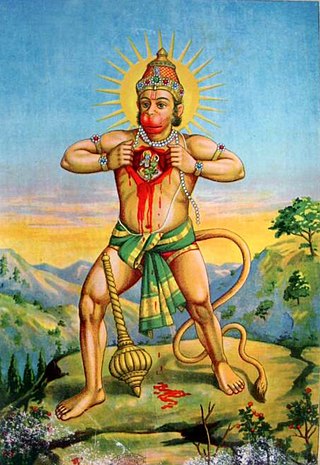
Hanuman, also called Maruti, Bajrangabali, and Anjaneya, is a Hindu god and a divine vanara companion of the god Rama. Hanuman is one of the central characters of the Hindu epic Ramayana. He is an ardent devotee of Rama and one of the chiranjivis. Hanuman is regarded to be the spiritual son of the wind-god Vayu, who in several stories played a direct role in Hanuman's birth. Hanuman is mentioned in several other texts, such as the epic Mahabharata and the various Puranas.
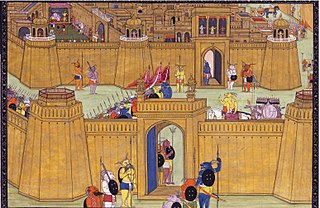
Lanka is the name given in Hindu epics to the island fortress capital of the legendary asura king Ravana in the epics of the Ramayana and the Mahabharata. The fortress was situated on a plateau between three mountain peaks known as the Trikuta Mountains. The ancient city of Lankapura is said to have been burnt down by Hanuman. After its king, Ravana was killed by Rama with the help of Ravana's brother Vibhishana, the latter was crowned king of Lankapura. His descendants were said to still rule the kingdom during the period of the Pandavas. According to the Mahabharata, the Pandava Sahadeva visited this kingdom during his southern military campaign for the rajasuya of Yudhishthira. The palaces of Ravana were said to be guarded by four-tusked elephants.

Shatrughna is a prince of Ayodhya, King of Madhupura and Vidisha, and a brother of Prince Rama in the Hindu epic Ramayana. He is also known as Ripudaman. He is the twin of Lakshmana. He is a loyalist of Bharata, just like Lakshmana is to Rama. According to the Valmiki Ramayana, Shatrughna is an incarnation of the Panchajanya. Shatrughna also appears as the 412th name of Vishnu in the Vishnu Sahasranama of the Mahabharata.

Mohini is the Hindu goddess of enchantment. She is the only female avatar of the Hindu god Vishnu. She is portrayed as a femme fatale, an enchantress, who maddens lovers and demons, sometimes leading them to their doom. Mohini is introduced into Hinduism in the narrative epic of the Mahabharata. Here, she appears as a form of Vishnu following the Churning of the Ocean, a mesmerising beauty who distributes the amrita to the weakened devas (gods) and depriving it to the dominant asuras (demons), allowing the former to defeat the latter with their newfound immortality.
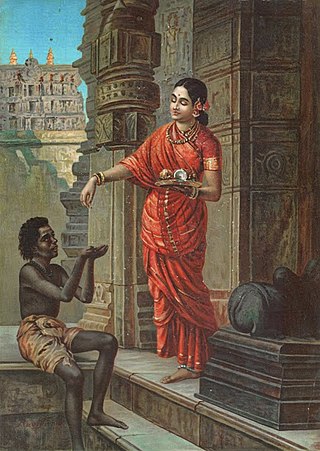
Mandodari was the queen consort of Ravana, the king of Lanka, according to the Hindu epic Ramayana. The Ramayana describes her as beautiful, pious, and righteous. She is extolled as one of the Panchakanya, the recital of whose names is believed to dispel sin.
In the Hindu epic, the Ramayana, Prahasta was a powerful rakshasa warrior and the chief commander of Ravana's army of Lanka. He was the son of Sumali and Ketumathi. In his next birth, Prahasta was reborn as Purochana in the Mahabharata as Duryodhana's trusted aide and was the main responsible for the Lakshagraha incident.

Shurpanakha, is a rakshasi (demoness) in Hindu epic. Her legends are mainly narrated in the epic Ramayana and its other versions. She was the sister of Lanka's king, Ravana, and the daughter of the sage Vishrava and the rakshasi Kaikeshi. Shurpanakha's role in the original epic is small, yet significant.
Danda is a region frequently mentioned in Hindu mythology, and is prominently featured in various narratives, such as Dandaka, which refers to both a kingdom and forest of the same name. Danda was a colonial state of Lanka during the reign of Ravana, with his governor Khara ruling the province. The region served as a stronghold for all the Rakshasa tribes living in the Dandaka Forest
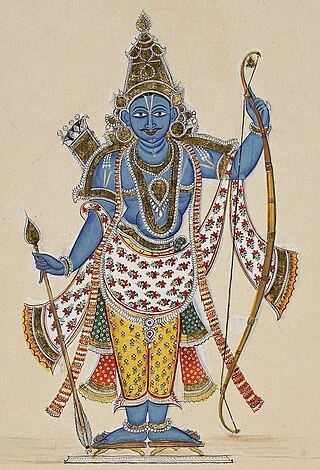
Rama is a major deity in Hinduism. He is the seventh and one of the most popular avatars of Vishnu. In Rama-centric traditions of Hinduism, he is considered the Supreme Being.

Gods, Demons and Others is a collection of short stories by R. K. Narayan adapted from Indian history and mythology, including epics like The Ramayana and Mahābhārata. In this book, Narayan provides both vitality and an original viewpoint to ancient legends.

The Panchakanya is a group of five iconic women of the Hindu epics, extolled in a hymn and whose names are believed to dispel sin when recited. They are Ahalya, Draupadi, Sita, Tara, and Mandodari. While Draupadi is from the Mahabharata, Ahalya, Sita, Tara, and Mandodari are from the Ramayana. The Panchakanya are regarded to be ideal women who exemplify perfect wives in Hinduism.

In some adaptations of the Hindu epic Ramayana, Maya Sita or Chaya Sita is the illusionary duplicate of the goddess Sita, who is abducted by the demon-king Ravana of Lanka instead of the real Sita.
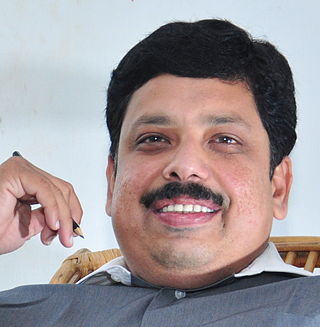
Anand Neelakantan is one of India's top selling authors with more than 13 books to his credit. Anand is also a columnist, screenwriter, and public speaker. He is known for writing mythological fiction and has authored Twelve books in English and one in Malayalam. He has also written screenplays for popular television series in Hindi in various GEC and OTT platforms. He has been writing a column named Acute angle in the New Indian Express since 2017. Anand has acted in two Advertisement films and has also played the role of the antagonist Ettappa Naicker in the Doordarshan Television show Swaraj. He follows the style of telling stories based on the perspective of the antagonists or supporting characters of a larger work. His debut work Asura: Tale of the Vanquished (2012) was based on the Indian epic Ramayana, told from the perspective of Ravana—the first book in his Ramayana series. It was followed by series of books based on characters from Mahabharata and Baahubali. His books have been translated to different languages such as Tamil, Hindi, Malayalam, Telugu, Kannada, Marathi, Bengali, Gujarati, Assamese, English, and Indonesian. Anand has written screenplays for popular Hindi television serials like Siya Ke Ram in Star TV, Mahabali Hanuman in SONY TV, Chakravarthy Ashoka in Colors TV, Sarfarosh in Netflix, Swaraj in DD National etc. He has written the story for the OTT series TAJ in Zee5

Jayanta, is a character who appears in Hindu literature. He is the son of Indra, the king of the devas (gods), and his wife, Shachi (Indrani). He has a sister called Jayanti.

Scion of Ikshvaku is a one to one replica of the events taking place before the epic tale "Ramayana" and also the fourth book of Amish Tripathi, fourth book of Amishverse, and first book of Ram Chandra Series. It was released on 22 June 2015. It is based on Ram, the legendary Indian king regarded as an incarnation of Vishnu. The title was revealed by the author at the Jaipur Literature Festival. The story begins with King Dashrath of Ayodhya being defeated in a war by Lankan trader Raavan, and the birth of his son Ram. It follows through Ram's childhood and tutelage, along with the politics surrounding his ascension to the throne, and ultimately his 14-year exile, accompanied by wife Sita and brother Lakshman.

Ajaya: Roll of the Dice is a 2013 Indian novel of mythological fiction written by Anand Neelakantan. The first installment of the Ajaya series, it tells the story of the Kauravas. As opposed to the usual tale told from the point of view of the victors, this entire story is written from Duryodhana's point view.

















